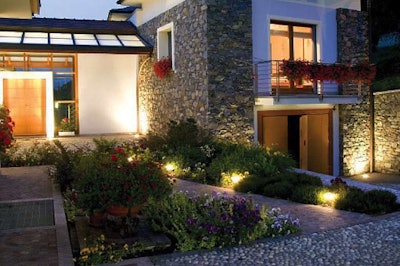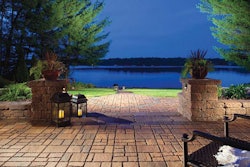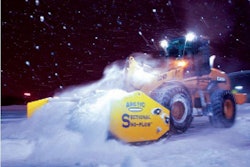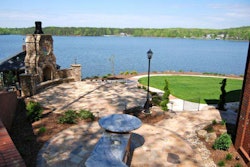
Lighting services can be a profitable addition to your business.
Do your customers grin when they write you a check for a landscape job? Not likely. But when Tanek Hood with Reynolds Landscaping in Manahawkin, New Jersey, flips the switch of an outdoor lighting project, illuminating the plants, trees, hardscape, art features and walkways of a newly installed landscape, the client almost always lets out a gasp of delight.
“You get the ‘wow’ factor after a light installation,” Hood says. “As a light designer, the landscape is your canvas.” Not only is the client elated and the neighbors instantly envious, but Hood just added a sweet 40-percent profit to his bottom line. And the prospect of future business is all but assured. “When you add any amount of lighting, it’s addictive. The client usually comes back for more,” says Hood, who leads the Reynolds’s lighting division.
If you operate even a small landscape business, you may be surprised how adding low-voltage lighting design and installation is such a natural fit. Unlike a typical start-up, you already have the clientele, tools, labor and expertise about the terrain. Low-voltage lighting is safe when properly installed and, except in a few states and municipalities, doesn’t require an electrician’s license.
Paul Gosselin, owner of Texas-based Nightscenes Landscape Lighting Professionals, says entering the lighting business successfully hinges on doing your homework. “You can’t just fake it till you make it in this line of work,” Gosselin says. Plenty of information, training and certification are available from associations and manufacturers, and it’s worth your while to seek out every opportunity you can to educate yourself.
Getting started
The first call you make should be to check your local building department for licensing and certification requirements, which vary by state. Check online at licensedelectrician.com for your state’s requirements. While most states don’t require an electrician’s license to install low-voltage lighting, it’s important to understand your area’s requirements. Some neighborhood associations are members of the International Dark Sky Campaign, and your lighting must comply with their restrictions as well.
Training
Take advantage of every educational opportunity available. “Nothing hurts the lighting industry more than when a uniformed DIY homeowner or flying-by-the-seat-of-his pants landscaper installs low-quality, big-box lighting products that fail. “Instead of blaming the product or installer, customers get an overall negative impression of outdoor lighting,” Gosselin says.
There are no clearly defined national standards for low-voltage outdoor lighting. That’s why Association of Outdoor Lighting Professionals (AOLP) offers certification for installation/maintenance (Certified Low Voltage Lighting Technician) and outdoor lighting design (Certified Outdoor Lighting Designer). The certification can be extremely helpful in getting started. Hood earned his COLD certification, which takes four years.
“I learned so much by working through the certification process, and it pays off by increasing my expertise in the field,” Hood says.
Newbies can find a wealth of information from training classes offered by lighting manufacturers. Jeff Hesser, in Hawthorne, New Jersey, is the Mid-Atlantic sales manager for Cast Lighting and has worked with hundreds of contractors as they get started in the lighting business. Cast Lighting offers hands-on courses that cover installation, marketing, sales and design. “Contractors get really excited when they see how adding lighting design and installation can increase profits and grow the business,” Hesser says.
Ronald Carter, Kichler Lighting’s corporate trainer, says Kichler’s “Introduction to Landscaping” classes in Cleveland, Ohio, sell out quickly. The one-day seminars designed for novice landscape lighting professionals offer hands-on training in installation, incandescent versus LED systems, wattage, beam spread and the fundamentals of electrical and voltage differences.
Participants also learn how to sell and grow their business. Carter, who has more than 20 years of experience in lighting, says the classes give novices the confidence and practical knowledge they need to get started.
In addition to training seminars, many contractors find a wealth of information from books such Janet Lennox Moyer’s The Landscape Lighting Book, considered the bible of lighting books. Many new lighting professionals flock to online forums such as lawnsite.com. Hood says he’s impressed how more-experienced lighting professionals will offer tips to novices.
Marketing
Look no further than your client list to get started in the lighting business. “If you don’t already have an email list, now is the time to get one,” Hood says. Nearly all of his customers, even elderly ones, have an email address they are willing to provide. “Next, send out an email blast touting the benefits of adding lighting to your landscape.” The customer already has a relationship with you and might have never thought about lighting.
The main points – beauty, security and safety (for the homeowner and his guests) are easily sold.
Carter, like many lighting experts, believes good photography is the key to closing the deal. He also teaches a photography section at his seminars and says the visual effects of before/after, day/night photos leave a strong impression.
Hood agrees and, in fact, was a photographer before he became involved in landscape lighting and continues to photograph his work. “The study of light is equally important to lighting professionals and photographers,” he says. “Understanding shadows and contrast along with designing aesthetically appealing and functional lightscapes is an art form. However, few first-time customers can appreciate the full impact of what a lightscape can do for their property. Photos of other projects help bridge that gap.”
Display photos provided by manufacturers on your website until you can build your own photo gallery. Marketing tools such as door hangtags, flyers and brochures all help get the word out about your business.
How much can you make?
This can be the most profitable part of your business if you price it correctly. Many novices are hesitant to even price the hardware at suggested retail, but that’s a mistake, Gosselin says. The standard profit margin is in the 30- to 40-percent range, and a typical residential installation can vary from $5,000 to $7,500, with prices differing throughout the country.
Start-up costs
Approximate costs to get started as a lighting contractor:
• Basic landscaping tools
$100-$200
Shovel, narrow trenching shovel, clean-out shovel, wire spooler, sod spade, etc.
• Basic electrician tools
$50-$100
Wire strippers, needle-nose pliers, flat and Phillips head screwdrivers, electrical meter, rubber mallet
• Voltmeter with ammeter clamp
$130-$160
• Certification
$450 + travel expenses
AOLP’s Certified Low Voltage Lighting Technician
• Training
< $500 + travel expenses
Training classes offered by manufacturers and distributers range from free to moderately priced.
• Demo lighting kit
$400-$900
You should practice on your home or offer a customer a discount to practice installation and experiment with wattage and beam spread effects.
• Insurance
$$$
Inform your insurance company you are adding lighting and carry adequate liability coverage.
Leery of LEDs?
Problem: My customers are wary of the cost and aesthetics of LED lights. How do I sell them on the product?
Solution: Paul Gosselin, president of the Association of Outdoor Lighting Professionals, says LED outdoor lighting is here to stay. He’s gone to 100-percent LED in his business. “You have to educate your client about the true costs,” he says. “While LED may cost about 20 percent more than a halogen system, the system uses 75 percent less energy and requires significantly less maintenance. So, they actually end up paying less than half of what a halogen system would cost during its lifespan. If you offer a clear explanation, they usually decide to go with LED.”











